This article was co-authored by Chris M. Matsko, MD. Dr. Chris M. Matsko is a retired physician based in Pittsburgh, Pennsylvania. With over 25 years of medical research experience, Dr. Matsko was awarded the Pittsburgh Cornell University Leadership Award for Excellence. He holds a BS in Nutritional Science from Cornell University and an MD from the Temple University School of Medicine in 2007. Dr. Matsko earned a Research Writing Certification from the American Medical Writers Association (AMWA) in 2016 and a Medical Writing & Editing Certification from the University of Chicago in 2017.
There are 10 references cited in this article, which can be found at the bottom of the page.
wikiHow marks an article as reader-approved once it receives enough positive feedback. In this case, 90% of readers who voted found the article helpful, earning it our reader-approved status.
This article has been viewed 296,928 times.
Steaming is an old method of relieving sinus pressure without chemicals or drugs. The steam helps open up the nasal passages and thin out the sometimes thick mucus, thereby enabling it to drain out of the sinuses. Steam treatments can be used along with medicinal pain relievers, antibiotics, and antifungal treatments as prescribed by your physician. If you are already on medication, continue taking the medication along with steam treatments. However, if you have not yet consulted your physician, try these steam treatments first. If you don't experience relief within five to seven days, then you should make an appointment with your doctor.
Steps
Using Steam Only
-
1Fill a one-quart pot with water. Boil the water on the stove for a minute or two or until it is steaming vigorously. Then remove the pot from the heat.[1]
- Place the hot pot on a heat resistant mat on a table.
- Keep any children away from the pot while it is boiling and while it is steaming. Try to do a steaming treatment when there aren't any children around.
-
2Cover your head. Drape a large, clean cotton towel over your head and then place your head over the steaming pot.
- Close your eyes and keep your face at least 12 inches away from the water. You want the heat to enter your nose and throat, but you certainly don’t want to damage or burn yourself.
Advertisement -
3Breathe. Inhale through your nose and out through your mouth for five counts. Then reduce the inhales and exhales to two counts.[2]
- Repeat for 10 minutes or for as long as the water is still steaming.
- Try to blow your nose during and after the treatment.
-
4Use this technique frequently. You can give yourself a steam every two hours or as often as your schedule permits.
-
5Consider steaming on the go. If you're busy and not able to boil a pot of water and sit over it, consider placing your face over the steam coming from a hot tea or bowl of soup when you're at work or out and about. The goal and effect is still the same, even if the source of steam is different![3]
- A humidifier can also be utilized for this method of relieving the sinuses.
Steaming With Herbs
-
1Fill a one-quart pot with water. Boil the water on the stove for a minute or two or until it is steaming vigorously. Then remove the pot from the heat.
-
2Add 1-2 drops of an essential oil. Start with 1 drop/quart of water. The following essential oils have either antibacterial, antifungal or antiseptic properties, meaning they can kill bacteria and other microorganisms that can infect the sinuses:
- Spearmint or peppermint - Both peppermint and spearmint contain menthol which has antiseptic and immune-boosting properties.[4]
- Thyme, sage, and oregano - These herbs boost the immune system and have antibacterial properties. They also increase circulation of the blood by opening up blood vessels.[5] [6]
- Lavender - Lavender is known as a soothing herb that also has antibacterial properties. It will help you feel calm and relaxed and can relieve anxiety and depression.[7] [8]
- Black walnut oil - If you know you have a fungal sinus infection, add black walnut oil, which has antifungal, antimicrobial, and antiseptic properties.[9]
- Tea tree oil - Tea tree oil has antiviral, antifungal, and antiseptic properties and has provided relief to some people suffering from sinus infections.[10]
-
3Use dry herbs. If you don’t have the above essential oils on hand, you can substitute ½ teaspoon of dried herb per quart of water.
- Once you add the herbs, boil for another minute, turn off the heat and move the pot to a comfortable area and begin steaming.
-
4Always test any herb for sensitivity. Each time you try a new herb, give yourself a test to make sure that you don't have any adverse reaction, such as sneezing or skin irritation. Make the concoction and steam your face with the new herb for about a minute. Then, take your face away from the steam for 10 minutes and wait.
- If you don't notice any irritation or other reaction, reheat the water and do the full steam treatment.
Using Other Home Remedies to Relieve Sinus Pressure
-
1Use a humidifier. To help improve the health of your sinuses, place a humidifier in your bedroom while you sleep. A humidifier produces steam and moist air, which will help clear out the nasal passages.[11]
- When your nasal passages are blocked, you need to focus on keeping your nasal passages and sinuses moist. Although many people think that if you have have a runny nose, that dry air is the trick, dry air only further irritates the membranes in your nasal passage.
- Humidifiers are especially good during the wintertime because the air in most homes is very dry due to central heating.[12]
- Even placing a hot water bottle near the ear may have a similar effect and help to draw out ear fluid.
-
2Take hot showers. Taking a long, hot shower works very similarly to the steam treatments described above. The hot water from the shower creates warm, moist air that is useful in clearing out blocked nasal passages and relieving sinus pressure.[13]
- You also achieve a similar beneficial effect by placing a warm compress on your face to help open up your nasal passages and relieve any pressure you might be feeling in your sinuses.[14]
-
3Drink fluids. Make sure that you drink lots of water (at least 8 full glasses a day) because this will thin out your mucus and can help prevent sinuses blockages, and thereby ease pressure.[15]
- Thinned out mucus is much more likely to drain. Whenever you feel the beginnings of sinus pressure, make a concerted effort to stay hydrated.[16]
-
4Keep your head elevated. When you go to sleep at night, place a couple of pillows beneath your head so that it is elevated. This will make breathing easier and keep the sinus pressure from building up.[17]
Expert Q&A
Did you know you can get expert answers for this article?
Unlock expert answers by supporting wikiHow
-
QuestionHow do I treat a 2 year old baby with a sinus infection?
 Chris M. Matsko, MDDr. Chris M. Matsko is a retired physician based in Pittsburgh, Pennsylvania. With over 25 years of medical research experience, Dr. Matsko was awarded the Pittsburgh Cornell University Leadership Award for Excellence. He holds a BS in Nutritional Science from Cornell University and an MD from the Temple University School of Medicine in 2007. Dr. Matsko earned a Research Writing Certification from the American Medical Writers Association (AMWA) in 2016 and a Medical Writing & Editing Certification from the University of Chicago in 2017.
Chris M. Matsko, MDDr. Chris M. Matsko is a retired physician based in Pittsburgh, Pennsylvania. With over 25 years of medical research experience, Dr. Matsko was awarded the Pittsburgh Cornell University Leadership Award for Excellence. He holds a BS in Nutritional Science from Cornell University and an MD from the Temple University School of Medicine in 2007. Dr. Matsko earned a Research Writing Certification from the American Medical Writers Association (AMWA) in 2016 and a Medical Writing & Editing Certification from the University of Chicago in 2017.
Family Medicine Physician
-
QuestionIs there a plant that helps with sinusitis?
 Chris M. Matsko, MDDr. Chris M. Matsko is a retired physician based in Pittsburgh, Pennsylvania. With over 25 years of medical research experience, Dr. Matsko was awarded the Pittsburgh Cornell University Leadership Award for Excellence. He holds a BS in Nutritional Science from Cornell University and an MD from the Temple University School of Medicine in 2007. Dr. Matsko earned a Research Writing Certification from the American Medical Writers Association (AMWA) in 2016 and a Medical Writing & Editing Certification from the University of Chicago in 2017.
Chris M. Matsko, MDDr. Chris M. Matsko is a retired physician based in Pittsburgh, Pennsylvania. With over 25 years of medical research experience, Dr. Matsko was awarded the Pittsburgh Cornell University Leadership Award for Excellence. He holds a BS in Nutritional Science from Cornell University and an MD from the Temple University School of Medicine in 2007. Dr. Matsko earned a Research Writing Certification from the American Medical Writers Association (AMWA) in 2016 and a Medical Writing & Editing Certification from the University of Chicago in 2017.
Family Medicine Physician
Warnings
- Avoid leaning in too close to the pot of steaming water and be sure to keep your face a safe distance of 12 inches from the steaming water.⧼thumbs_response⧽
- Never do a steam treatment over boiling water due to the risk of burning yourself.⧼thumbs_response⧽
- Always keep children away from boiling water.⧼thumbs_response⧽
References
- ↑ http://www.emedicinehealth.com/sinus_infection/page6_em.htm
- ↑ http://www.emedicinehealth.com/sinus_infection/page6_em.htm
- ↑ http://www.sudafed.com/know/sinus-pain-headache-pressure
- ↑ Kamatou GP, Vermaak I, Viljoen AM, Lawrence BM., Menthol: a simple monoterpene with remarkable biological properties.Phytochemistry. 2013 Dec;96:15-25.
- ↑ Fournomiti M, Kimbaris A, Mantzourani I, Plessas S, Theodoridou I, Papaemmanouil V, Kapsiotis I, Panopoulou M, Stavropoulou E, Bezirtzoglou EE, Alexopoulos A. Antimicrobial activity of essential oils of cultivated oregano (Origanum vulgare), sage (Salvia officinalis), and thyme (Thymus vulgaris) against clinical isolates of Escherichia coli, Klebsiella oxytoca, and Klebsiella pneumoniae. Microb Ecol Health Dis. 2015 Apr 15;26:23289.
- ↑ Sienkiewicz, M.,Łysakowska, M., Ciećwierz, J.,Denys, P.,Kowalczyk, E.Antibacterial activity of thyme and lavender essential oils. Med Chem. (UAE); 7(6): 674-689, 2011.
- ↑ Ait Said L, Zahlane K, Ghalbane I, El Messoussi S, Romane A, Cavaleiro C, Salgueiro L.Chemical composition and antibacterial activity of Lavandula coronopifolia essential oil against antibiotic-resistant bacteria. Nat Prod Res. 2015;29(6):582-5.
- ↑ Sienkiewicz, M.,Łysakowska, M., Ciećwierz, J.,Denys, P.,Kowalczyk, E.Antibacterial activity of thyme and lavender essential oils. Med Chem. (UAE); 7(6): 674-689, 2011.
- ↑ Rathi,P. Ahmad, M., Tomar,A. Study on Antimicrobial and antioxidant properties of WALNUT (Juglans nigra) OIL.Int.J.Curr.Res.Chem.Pharma.Sci.1(7):51-55. 2014.
- ↑ Hammer, KA., Carson, CF., Riley, TV. Antifungal activity of the components of Melaleuca alternifolia (tea tree) oil. Antifungal activity of the components of Melaleuca alternifolia (tea tree) oil
- ↑ http://www.webmd.com/allergies/sinus-pain-pressure-11/sinus-congestion
- ↑ http://www.webmd.com/allergies/sinus-pain-pressure-11/sinus-congestion
- ↑ http://www.emedicinehealth.com/sinus_infection/page6_em.htm
- ↑ http://www.webmd.com/allergies/sinus-pain-pressure-11/sinus-congestion
- ↑ http://www.emedicinehealth.com/sinus_infection/page6_em.htm
- ↑ http://www.sudafed.com/know/sinus-pain-headache-pressure
- ↑ http://www.webmd.com/allergies/sinus-pain-pressure-11/sinus-congestion
About This Article
If you’re struggling with sinus pain, you can use steam to help relieve some of the pressure. Fill a one-quart pot with water and bring it to a boil for 1-2 minutes, then remove it from the heat. Drape a large, clean towel over your head and place your head about a foot above the water. Stay like that for about 10 minutes, inhaling through your nose and exhaling through your mouth. Blow your nose during and after the treatment, and repeat every two hours until your sinus pressure is relieved. Keep reading for tips from our medical reviewer on adding herbs like lavender or sage to your water!
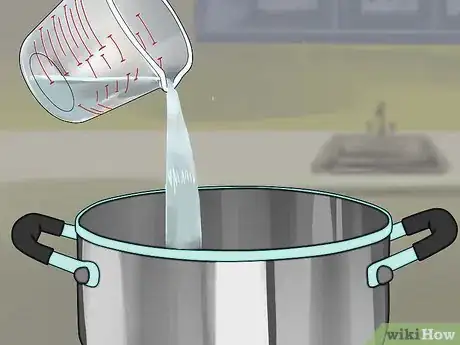

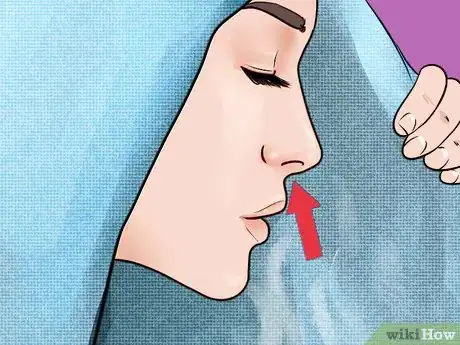
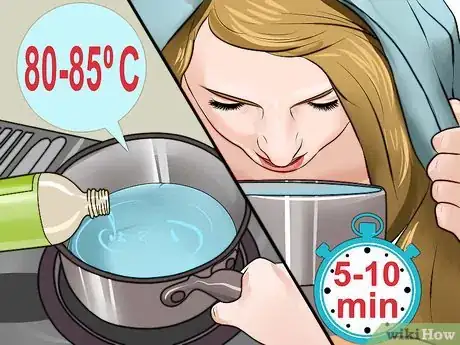
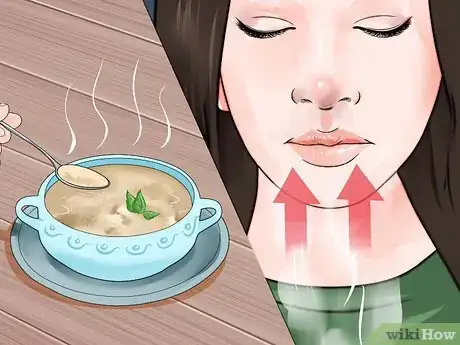
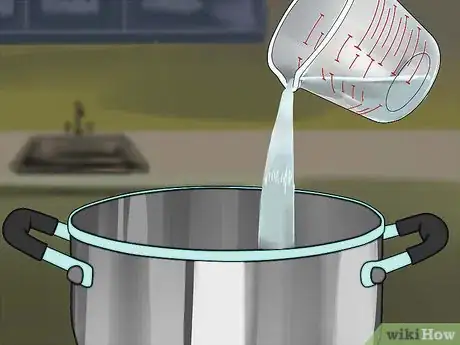
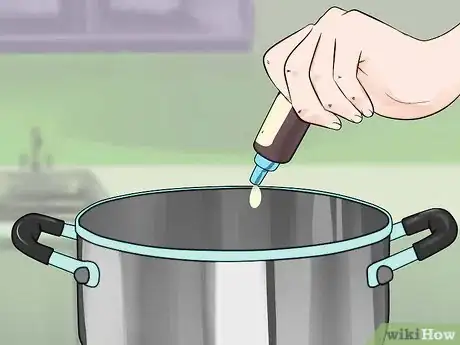
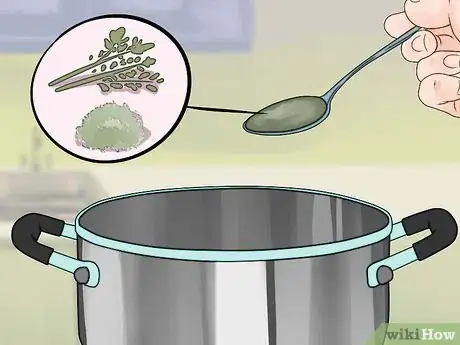

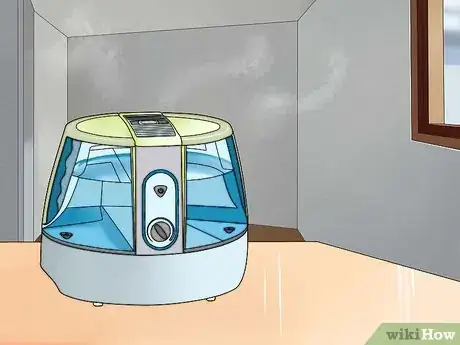
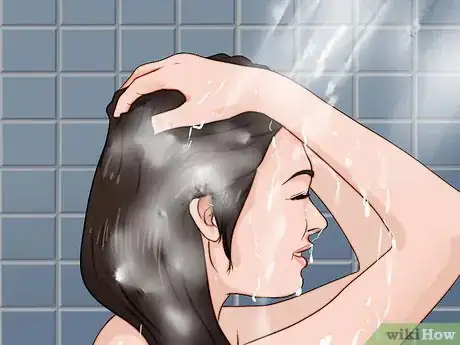

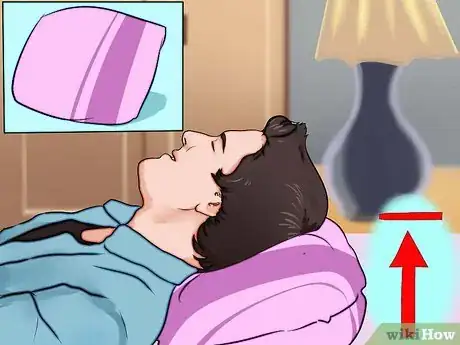



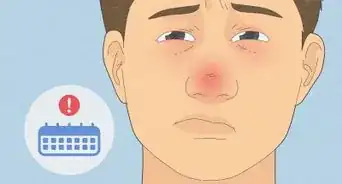


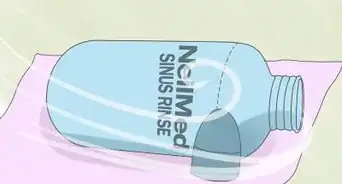




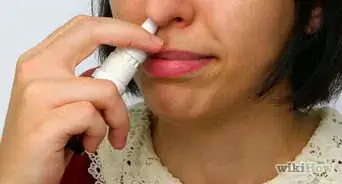














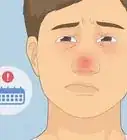



































Medical Disclaimer
The content of this article is not intended to be a substitute for professional medical advice, examination, diagnosis, or treatment. You should always contact your doctor or other qualified healthcare professional before starting, changing, or stopping any kind of health treatment.
Read More...